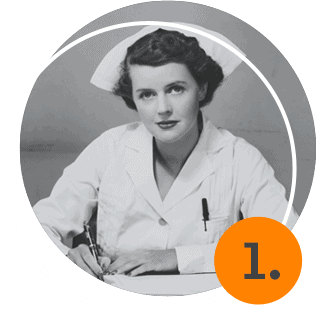
Nursing education and clinical practice have come a long way since the days of Florence Nightingale. In fact, with rapid advancements continuously being made in health care and technology, nursing today is very different than it was even just a few years ago. As a result, many things that were once considered standard have become history for nursing students. Here are a few examples:

Wearing nursing whites and a nursing cap.
Sure, it’s fun wearing a nursing cap, or “flossie” as they used to be known, for capping, pinning, and graduation ceremonies, but can you imagine what it must have been like wearing one every day as a practicing nurse? Nursing can be physically demanding, so we bet those hats ended up on the floor on a regular basis. And remember the traditional white uniform? Today’s nurses can thankfully wear comfortable scrubs in colors that are more body-fluid friendly than pure whites. And for female nurses, wearing pants means more physical flexibility and less chance of a skirt-related wardrobe malfunction.

Relying solely on paper charts and records.
While many facilities still use paper for some tasks, most have made the transition to electronic health records. Going digital has made it much easier to access and transfer medical records, as well as chart patient care on computers and mobile devices. What used to require digging through a sea of paper charts can now be retrieved with just a few clicks. EHRs are even a vital part of today’s nursing education with programs such as SimChart® that provide real-world practice in electronic charting.

Getting limited exposure to certain conditions in clinicals.
When conducting clinicals in a traditional hospital setting, nothing is guaranteed. The types of patients and conditions nursing students experience is limited to what is happening on the floor that day. With state-of-the-art simulations, however, today’s students can gain valuable hands-on practice with a virtually unlimited variety of scenarios — from basic procedures, to emergencies, to rare and complex conditions — and enter practice with the skills they need to provide safe, effective nursing care.

Having a one-dimensional learning experience.
What did we ever do without digital technology? If you can remember a time before technology dominated so many aspects of our lives, you probably recall long (and sometimes boring) lectures, endless dry textbook reading assignments, and uninspiring homework. Oh, how times have changed! Emerging learning technologies, such as Sherpath and Elsevier Adaptive Quizzing, have transformed nursing education into an engaging, interactive, game-like, multidimensional, and personalized experience.

Blindly taking the NCLEX® exam.
Sure, back in the day nursing students could prepare for the NCLEX exam by reviewing their notes and pouring over textbooks. They might have even taken a practice exam with pencil and paper. But they didn’t really know if they had what it took to pass until they got their results. Students today can go into the NCLEX exam with confidence thanks to standardized testing resources such as HESI. With valid and reliable exams, personalized remediation, and detailed reporting and analytics, HESI can predict NCLEX-RN exam pass rates with up to a 98.26% accuracy rate.